Disclosure: We may earn commissions if you purchase products after clicking on a link from our site.
Do you want to experience the thrill of fishing for Mahi Mahi? Do you want to learn how to catch Mahi Mahi? It is a favorite of anglers as it is an aggressive fish that puts up a strong fight when it is hooked. Additionally, Mahi Mahi is one of the best-eating fishes. In this article, we will discuss how to catch Mahi Mahi, the fishing techniques, the bait and lures, and the equipment you need.
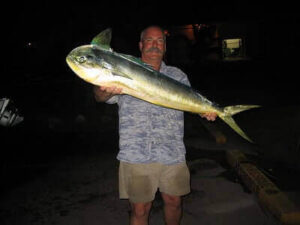
Table of Contents
- 1 How To Catch Mahi Mahi
- 2 Mahi Mahi Fishing Tackle
- 3 How To Catch Mahi Mahi From Shore
- 4 How To Catch Mahi Mahi In Florida
- 5 How To Catch Mahi Mahi In Destin Florida
- 6 How To Catch Mahi Mahi In The Gulf
- 7 How To Catch Mahi Mahi In Hawaii
- 8 Best Baits For Mahi Mahi
- 9 Best Lures For Mahi Mahi
- 10 Mahi Mahi Fishing Tips
- 11 The Bottom Line
How To Catch Mahi Mahi
1. Trolling
Trolling is one of the popular fishing methods for catching Mahi Mahi on open water. When trolling, offshore anglers move the boat slowly and let their fishing line move in the water. Drop the bait close to floating seaweed, debris, flotsam, debris, rip currents, commercial fishing gear floats, or spinnakers. When you get a bite, you take control and reel in the fish.
Mahi Mahi is a strong fish that will put up a hard fight, and jump in the air when it is hooked. Therefore, be ready for a fight to win control and get the fish into the boat. Set up multiple lines, preferably 3 to 4, to increase your chances of getting Mahi Mahi.
2. Casting
Casting is a popular fishing method for targeting mahi mahi, also known as dolphin fish or dorado, particularly when these vibrant-colored pelagic species are spotted near the surface. Anglers typically use lightweight spinning or baitcasting tackle to cast lures or bait toward feeding mahi mahi.
This technique allows anglers to cover a large area of water and accurately present their offerings to actively feeding fish. Common lures for casting include brightly colored surface poppers, swimbaits, and topwater plugs that mimic the movements of small baitfish.
By imitating the natural prey of mahi mahi, anglers can trigger aggressive strikes from these highly prized game fish. For more information on fishing techniques and regulations, visit the website of the National Oceanic and Atmospheric Administration (NOAA) at link.
3. Jigging
Jigging is a versatile fishing technique that can be highly effective for catching mahi mahi, also known as dolphin fish or dorado. When targeting mahi mahi using jigging, anglers typically employ specialized jigs designed to imitate the movements of small baitfish or squid, which are prime prey for these pelagic predators.
Anglers vertically jig these lures up and down through the water column, mimicking the erratic movements of wounded or fleeing prey. Mahi mahi are known to be curious and aggressive feeders, making them susceptible to striking jigging lures that resemble their natural forage.
This method allows anglers to cover various depths and structure types, making it effective in both offshore and nearshore environments. Successful jigging for mahi mahi often requires patience, technique, and a keen understanding of the fish’s behavior.
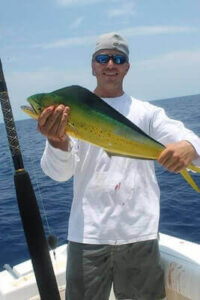
4. Drifting
Drifting is a popular and productive fishing method for targeting mahi mahi, especially in offshore environments where these pelagic species roam. Anglers employing the drifting technique use the natural currents and wind to slowly and silently drift across productive areas, such as weed lines, floating debris, or underwater structures where mahi mahi are known to congregate.
By presenting live baitfish, cut bait, or artificial lures in the drift path, anglers entice mahi mahi to strike as they pass by. Drifting allows anglers to cover a large area efficiently, increasing the chances of encountering schools of feeding mahi mahi.
Additionally, drifting allows baits to move naturally through the water, mimicking the behavior of prey items and enticing strikes from hungry fish. To maximize success when drifting for mahi mahi, anglers should pay close attention to water conditions, currents, and the presence of baitfish. Here is a link to more information about mahi mahi fishing from Clemson University.
Mahi Mahi Fishing Tackle
A 7-foot heavy action rod with a 30 to 50-lb braided or fused line will work for fishing Mahi Mahi. Use a leader that ranges from 30 to 80-pound fluorocarbon and circle hooks of 6/0 to 9/0.
How To Catch Mahi Mahi From Shore
Most often you will find juvenile Mahi Mahi close to the shore even though adult Mahi Mahi can be found closer to the shore when the waters get warm. You can cast your fishing line in the waters from the shoreline using bait or lures to get Mahi Mahi.
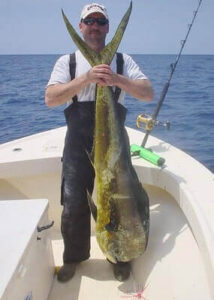
How To Catch Mahi Mahi In Florida
When fishing for mahi mahi in Florida, look for weed lines, especially sargassum. It is an orange-brown mass of weed lines that clump together. You will spot them on the surface swimming on the water surface. Mahi mahi can often be found around the weed line.
Additionally, floating pieces of structure also attract mahi mahi. Any kind of structure or a broken object that is floating will attract mahi mahi. Strong currents and temperature breaks are also areas where you can find mahi mahi as they like warm waters and temperature breaks.
When fishing for mahi mahi and you see birds circling overhead, that is a good sign that bait fish is the target of the birds and be sure that mahi mahi is also in that area trying to get their full share of the baitfish.
Trolling, drift fishing, deep sea fishing, and spinning are some of the fishing methods to catch mahi mahi. Ballyhoo is the choice of many anglers as bait when fishing for mahi mahi. Squid also works as well as lures.
How To Catch Mahi Mahi In Destin Florida
Mahi mahi likes to swim close to the surface. They are often found in waters with temperatures in the range from 68 to 83 degrees Fahrenheit. Mahi mahi can be in deep waters, as deep as 150 feet, or shallow waters. Look for weed lines, sargassum which is a kind of seaweed that clumps together offshore. Mahi mahi can often be found around it.
Additionally, floating pieces of structure also attract mahi mahi. If you spot any floating piece of structure, try fishing for mahi mahi around it. Offshore currents are also an area that attracts mahi mahi as they are attracted to warm water and temperature breaks.
When fishing for mahi mahi in Destin deep sea fishing, light tackling, spinning, trolling, and drift fishing are fishing methods used to catch mahi mahi. Squid and ballyhoo are baits used to catch mahi mahi in Destin, Florida.
How To Catch Mahi Mahi In The Gulf
The Gulf of Mexico is a fishing destination for many anglers, especially in the spring. Mahi mahi can be found all along the Gulf; Weedlines, floating structures, areas with strong currents, and temperature breaks are also places to target for mahi mahi.
Ballyhoo and squid are some of the favorite baits used to catch mahi mahi although lures can get the job done. Trolling is the preferred fishing method used by anglers but drift fishing, and deep-sea fishing are also used to great effect.
How To Catch Mahi Mahi In Hawaii
When fishing for mahi mahi in Hawaii, look for weed lines, areas with strong currents, floating structures, and temperature breaks. Any kind of floating structure tends to attract them. If you see floating structures, fish around them to find mahi mahi.
September to November and March to May are the best times to fish for mahi mahi in Hawaii. Squid, ballyhoo, and bullet heads are some of the baits often used when fishing for mahi mahi in Hawaii. Trolling is a popular fishing method but drift fishing, spinning, and deep-sea fishing are also used.
Best Baits For Mahi Mahi
1. Squid
Squid is a highly effective bait for mahi mahi fishing, prized for its natural appearance, enticing movement, and strong scent that attracts these predatory fish. Anglers often use whole or strip baits of squid, either freshly caught or frozen, depending on availability.
Squid can be rigged on hooks individually or in combination with other baitfish or artificial lures to enhance their attractiveness. The translucent and iridescent nature of squid makes them particularly appealing to mahi mahi, especially when fished near weed lines, floating debris, or offshore structures where these fish are commonly found.
Additionally, the squid’s durable texture allows it to withstand multiple strikes, increasing its longevity in the water and maximizing fishing opportunities. Overall, squid is a versatile and reliable bait choice for anglers targeting mahi mahi in both offshore and nearshore waters.
2. Mackerel
Mackerel is a popular bait choice among anglers targeting mahi-mahi due to its oily flesh, strong scent, and enticing swimming action that attracts these colorful pelagic fish. Whether used fresh, frozen, or rigged as live bait, mackerel effectively mimics the natural prey of mahi mahi, making it irresistible to these voracious predators.
Anglers often deploy mackerel baits with a variety of rigging techniques, including trolling, drifting, and casting, to cover different depths and areas where mahi mahi are likely to be found. Mackerel can be rigged whole, filleted, or used as cut bait, offering versatility in presentation to suit various fishing conditions and preferences.
When rigged properly, mackerel baits can entice aggressive strikes from mahi mahi patrolling offshore waters, making them an essential component of any angler’s arsenal when targeting these prized game fish.
3. Pilchards
Pilchards are highly regarded as bait for mahi mahi fishing due to their natural shimmer, lively swimming action, and enticing scent. These small, silvery fish are abundant in tropical and subtropical waters, making them a prime choice for anglers targeting mahi mahi, which are commonly found in similar regions.
Pilchards can be rigged in various ways to attract mahi mahi, including on trolling rigs, live bait rigs, or simply hooked through the nose or back. Their flashy appearance and natural swimming behavior make them irresistible to mahi mahi, enticing strikes from these acrobatic game fish.
Whether used fresh, frozen, or live, pilchards offer anglers a reliable and effective bait option for enticing mahi mahi bites and enhancing the excitement of offshore fishing adventures.
4. Jack Needlefish
Jack needlefish, also known as garfish or ballyhoo, are commonly used as bait for mahi mahi fishing due to their slender shape and shiny, silvery scales that mimic the appearance of small baitfish. These needlefish are abundant in coastal and offshore waters, making them easily accessible for anglers targeting mahi mahi in tropical and subtropical regions.
When rigged properly, such as with a wire or monofilament leader to prevent bite-offs, jack needlefish can be effective in attracting strikes from mahi mahi. Their natural swimming action and reflective scales make them a tempting target for hungry mahi mahi, enticing them to strike aggressively.
Whether trolled behind a boat, drifted with the current, or used as live bait, jack needlefish offer anglers a versatile and reliable option for enticing mahi mahi bites and enhancing the excitement of offshore fishing trips.
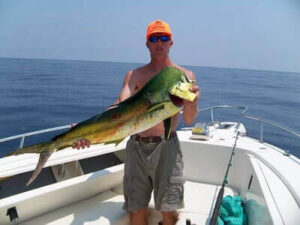
Best Lures For Mahi Mahi
1. Soft Plastic Jigs
Soft plastic jigs are a popular choice for anglers targeting mahi mahi due to their versatility and effectiveness in mimicking the movement of small baitfish, which mahi mahi feed on. These jigs come in a variety of shapes, sizes, and colors, allowing anglers to match the local baitfish species and conditions.
The soft plastic material provides a lifelike action in the water, enticing mahi mahi to strike. Anglers can rig these jigs with a single or treble hook, depending on the size of the bait fish and the preferred hooking method.
Whether cast and retrieved, trolled behind a boat, or jigged vertically, soft plastic jigs offer anglers a reliable option for targeting mahi mahi in both offshore and nearshore waters. Their durability and effectiveness make them a staple in the tackle boxes of anglers pursuing this prized game fish.
2. Diving Plugs
Diving plugs are a go-to lure for anglers targeting mahi mahi, known for their ability to dive into deep water and mimic the erratic swimming action of wounded baitfish. These lures typically feature a streamlined body with a diving lip that causes them to dive and wiggle when retrieved, closely resembling the movement of small prey fish.
Anglers can adjust the diving depth of these plugs by varying retrieval speed or using different models designed to dive to specific depths. The vibrant colors and flashy finishes of diving plugs attract the attention of mahi mahi, making them a highly effective option for enticing strikes.
Whether cast from shore, trolled behind a boat, or worked around offshore structures, diving plugs are a versatile and reliable choice for anglers looking to hook into mahi mahi on their next fishing adventure.
3. Bullet Heads
Bullet heads are popular lures for targeting mahi mahi, prized for their versatility and effectiveness in attracting these colorful pelagic fish. These lures typically feature a streamlined bullet-shaped head with a shiny metallic finish, designed to create a flashy and enticing presentation in the water.
Bullet heads are often rigged with colorful skirts or soft plastic trailers, adding additional movement and attraction to the lure. Anglers can employ a variety of retrieval techniques with bullet head lures, including trolling at different speeds, casting, and retrieving, or jigging near offshore structures.
The streamlined design and vibrant colors of bullet head lures make them highly appealing to mahi mahi, enticing strikes from these fast-swimming predators. Whether fishing inshore or offshore, bullet head lures are a go-to choice for anglers seeking to hook into the acrobatic and hard-fighting mahi mahi.
4. Bubblers
Bubblers are specialized lures designed to mimic the sound and appearance of a school of baitfish, making them an effective choice for targeting mahi mahi. These lures typically feature a hollow or concave head with multiple holes or slots, allowing water to enter and create a bubble trail as the lure moves through the water.
The bubbling action combined with the vibrant colors and lifelike swimming motion of the lure can attract the attention of mahi mahi, enticing them to strike. Anglers often deploy bubblers by trolling at varying speeds, allowing the lure to create an enticing trail of bubbles behind the boat.
The commotion and noise generated by the bubbling action can trigger aggressive feeding responses from mahi mahi, making bubblers a valuable addition to any offshore trolling spread.
5. Rigged Ballyhoo
Rigged ballyhoo is a popular and effective lure choice for targeting mahi mahi. Ballyhoo are slender baitfish with a streamlined body shape, making them a natural prey for many pelagic species, including mahi mahi.
Rigged ballyhoo refers to ballyhoo that have been prepared with a hook, leader, and often a colorful skirt or other attractant to enhance their appeal to gamefish. The lifelike swimming motion and shimmering appearance of the rigged ballyhoo can entice mahi mahi to strike, especially when presented at the proper trolling speed and depth.
Anglers commonly deploy rigged ballyhoo behind trolling lures or spreader bars, allowing them to mimic the movement of a school of baitfish and effectively cover a wide area of water. The versatility and proven effectiveness of rigged ballyhoo make them a staple in the arsenal of anglers targeting mahi mahi in offshore waters.
6. Artificial Squid
Artificial squid lures are a versatile and effective choice for targeting mahi mahi in offshore waters. These lures are designed to mimic the appearance and movement of natural squid, which are a common prey species for mahi mahi.
Artificial squid lures typically feature soft, flexible bodies with realistic tentacles and vibrant colors to attract the attention of mahi mahi. They may also incorporate features such as holographic finishes or internal rattles to enhance their visual appeal and increase their attractiveness to gamefish.
Anglers can deploy artificial squid lures in various ways, including trolling, casting, or drifting, depending on the fishing conditions and preferences. When trolled behind a boat, artificial squid lures can create a lifelike swimming action that entices mahi mahi to strike, especially when presented at the appropriate speed and depth.
Additionally, these lures can be rigged with hooks or teasers to increase their effectiveness and improve hookup rates. Overall, artificial squid lures are a popular choice among anglers for targeting mahi mahi due to their lifelike appearance, versatility, and proven ability to produce bites.
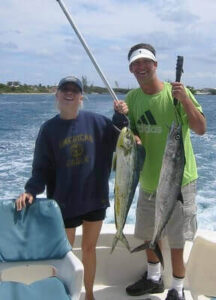
Mahi Mahi Fishing Tips
1. The spawning season for Mahi Mahi is from February to June.
2. Mahi Mahi is usually found around floating objects like flotsam, debris, spinnakers, or floating islands of grass.
3. Mahi Mahi likes waters between the surface and about 262 feet.
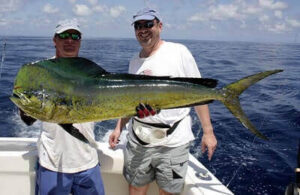
4. Mahi Mahi is a schooling fish. When fishing for them, you will find a school of fish.
5. It is a good time to fish for Mahi Mahi during the spawning season.
6. Mahi Mahi prefers water temperatures between 72 and 79 degrees Fahrenheit.
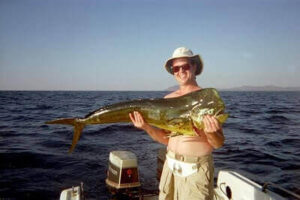
7. Live and dead bait and lures can be used to catch Mahi Mahi.
8. Trolling, jigging, and spinning are fishing methods used to catch Mahi Mahi.
9. Use natural and beautiful colors (white or yellow) and fluorescent colors in the mornings and evenings during low light conditions when you fish deep, over 100 feet.
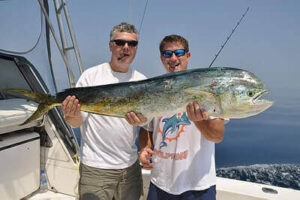
10. Mahi Mahi tends to jump out of the water when hooked.
11. When the waters start to warm up, Mahi Mahi can be found within 10 miles of the shoreline.
12. Mahi Mahi is a fast fish that swims from 50 to 57 knots.
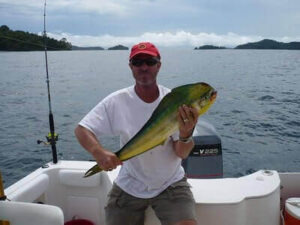
13. You have a high chance of finding Mahi Mahi in areas where there are canyons off the Mid-Atlantic coast when the water is warm.
14. Mahi Mahi can also be found around bass pots and over shoals.
15. Mahi Mahi will swim in offshore currents and temperature breaks.
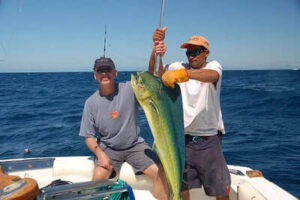
16. If you see birds circling overhead, that is a good sign that they are preying on fish that could also be bait for Mahi Mahi.
17. Troll the rip currents that are around floating seaweed.
18. Trolling between 2 and 9 knots is the consensus, but experiment until you find the right speed for the area.
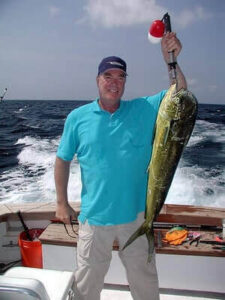
19. Always have a gaff when fishing for Mahi Mahi.
20. Jigging, spinning, and drifting are other fishing methods to catch Mahi Mahi.
21. When trolling for Mahi Mahi, you can chum to get the fish’s attention.
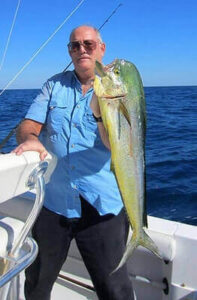
The Bottom Line
Mahi Mahi is a powerful, tasty, and big fish that is a favorite of anglers. It is found in the Atlantic Ocean, Pacific Ocean, Indian Ocean, and Mediterranean Sea. Mahi mahi is a member of the Actinopterygii family. When fishing for Mahi Mahi, target areas with floating debris, and weeds. Finding the right areas to target is key to succeeding with Mahi Mahi fishing.
If you are also interested in other fishes like marlin, largemouth bass, and haddock, then read these articles on how to catch marlin, how to catch largemouth bass, and how to catch haddock.
